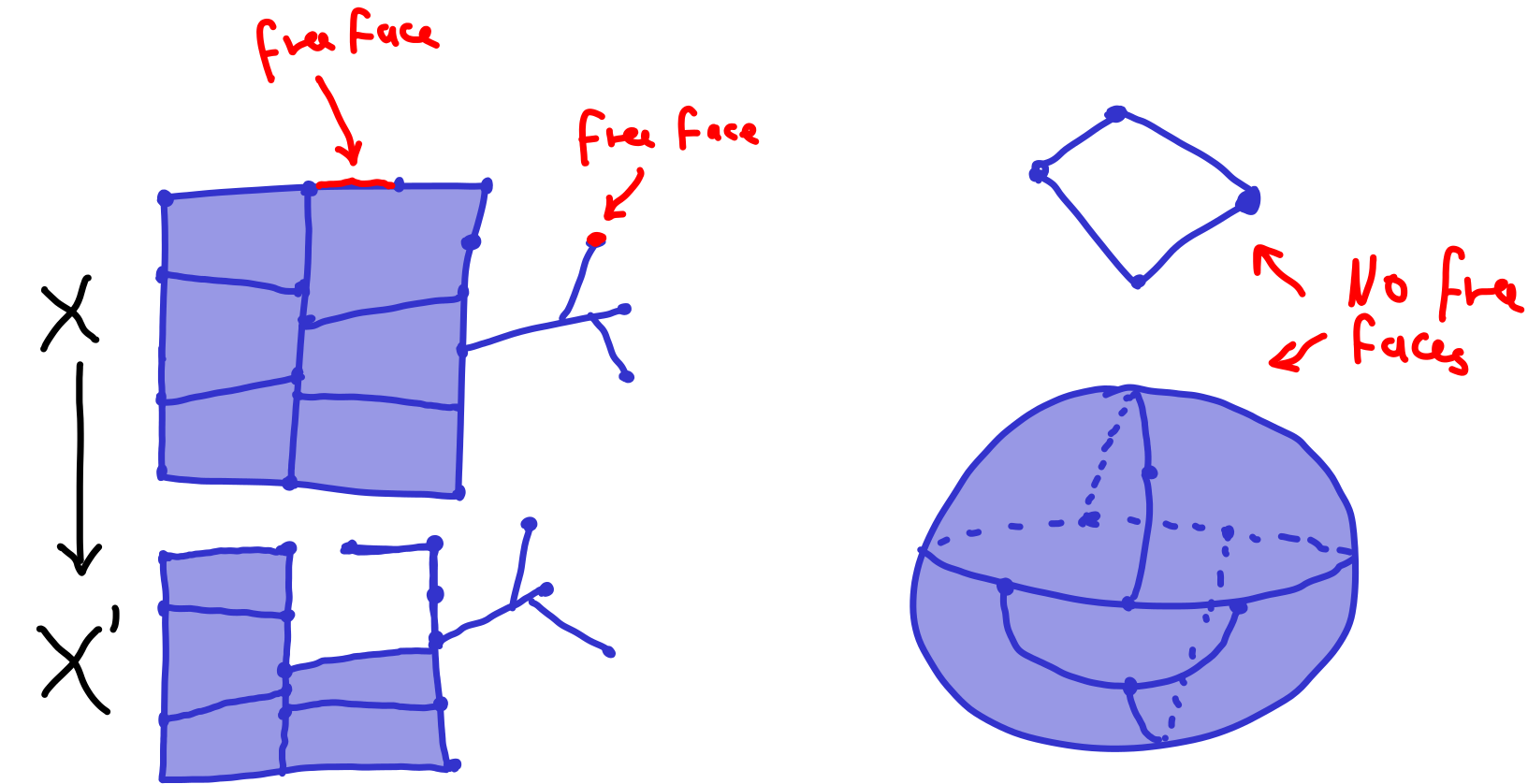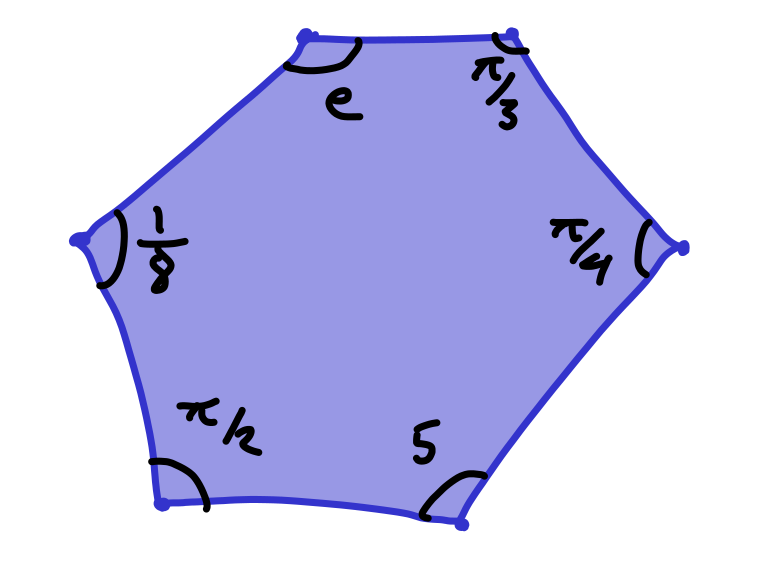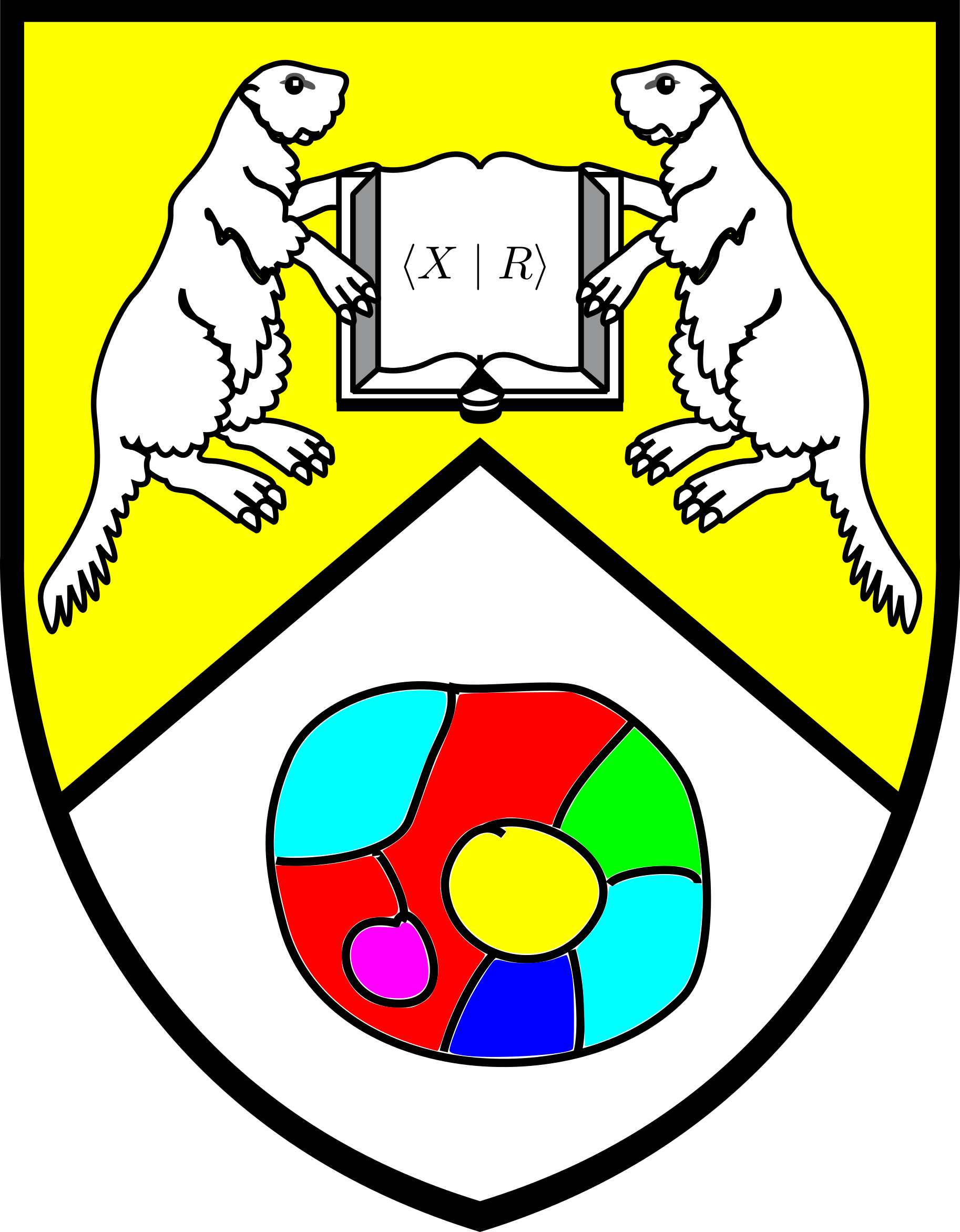Section 3.4 The combinatorial geometry and topology of van Kampen diagrams.
Although we've been using them for a few lectures already, we will now give formal definitions of 2-complexes.
An open \(n\)-cell is a copy of the open ball in \(\RR^n\text{.}\) For example an open \(1\)-cell is an open interval, and open \(2\)-cell is an open disc. We will now define a cell complex inductively as follows:
- A closed 0-cell is a point. A zero-complex is a disjoint union of points.
- A closed 1-cell consists of an open 1-cell (an interval) and a boundary consisting of two closed zero-cells, i.e. an open interval with it's two endpoints. We think of a 1-cell as being embeddable into \(\RR\text{.}\) Note that if an open cell is the 1-ball, then the 0-sphere (i.e. the points of distance 1 from the origin in \(\RR\)) consists of two points. A 1 complex is obtained by taking a collection of 1-cells and identifying points in their boundaries. Note that this is precisely the definition of an undirected graph that can contain multiedges and loops. A combinatorial mapping of 1-complexes is a function between 1 complexes which sends 0-cells to 0-cells and 1-cells to 1-cells.
- A closed 2-cell \(D\) consists of an open 2-cell and a boundary \(\partial B\) which is 1-complex homeomorphic to a circle (i.e. a closed polygon). Again we think of a 2-cell as being embeddable into \(\RR^2\text{.}\) A 2-complex \(X\) is obtained by taking \(X^{(1)}\text{,}\) called a 1-skeleton, and attaching 2-cells via the identification given by a combinatorial mapping \(\partial B \to X^{(1)}.\)
The reader will probably see that this construction generalized to arbitrarily high dimensions. For our purposes, however, it is sufficient to stay in dimension 2, i.e. to work with 2-complexes.
Now we note that 2-complexes can be realized, and should be thought of, as CW complexes, also called cell complexes. That said the data that goes into describing them is completely discrete. It actually turns out that many interesting topological spaces can be studied from a combinatorial viewpoint.
Subsection 3.4.1 Euler characteristic of van Kampen diagrams.
Given a finite (i.e. with finitely many cells) connected 2-complex \(X\) we have the following invariant called Euler Characteristic
Were \(V_X,E_X,F_X\) denote the number of vertices (0-cells), edges (1-cells), faces (2-cells) of \(X\) (respectively).
We will now define collapses which are transformations of cell complexes that are useful for inductive arguments. A free \(n\)-face in a cell complex \(X\) is an \(n\)-cell \(f\) which is contained in the boundary \(\partial \sigma\) of single open \(n+1\)-cell \(\sigma\text{.}\)

An elementary collapse of cell complex \(X\) at a free face \(f\) is the process of passing to \(X' \subset X\) which is optained by deleting the free \(n-face\) \(f\) and the unique open (\(n+1\))-cell \(\sigma\) containing \(f\text{.}\) We note that although \(X'\subset X\) we actually have a continuous function
such that the restriction \(r|_{X'} = Id_{X'}\text{,}\) so that \(r\) is a retraction. In fact \(r\) is a deformation retraction. The reader should not panic if they don't know what a deformation retraction is, as the following consequence of this fact (which can be proved directly from definitions) is all we will need.
Lemma 3.4.2.
If \(X \to X'\) is an elementary collapse then
We now turn our attention specifically to van Kampen diagrams, which we have defined as finite planar simply connected 2-complexes. We start with the following lemma.
Lemma 3.4.3.
Any van Kampen diagram, which is not a point, contains a free face and therefore admits an elementary collapse.
Proof.
We first consider the case where \(X\) contains 2-cells. First note that because \(X\) is planar every edge is contained in at most two 2-cells.

So \(X\) has 2-cells, but no free faces, then every connected union of 2-cells must be a closed 2-manifold (i.e. a compact 2 manifold without boundary) contradicting that \(X\) is planar.
We now consider the situation where \(X\) doesn't have any 2-cells. Then \(X\) is a finite graph. Since \(X\) is simply connected it doesn't contain any cycles, so \(X\) is a finite tree, therefore it contains vertices of degree 1, which are precisely free \(0\)-faces.
Having exhausted all possibilities, the result follows.
Corollary 3.4.5.
If \(X\) is a van Kampen diagram then \(\chi(X)=1.\)
Subsection 3.4.2 The combinatorial Gauss-Bonnet theorem for planar diagrams.
The classical Gauss-Bonnet theorem relates the integral of curvature over a Riemannian manifold to the manifold's Euler characteristic. We will now present a combinatorial version of this fact. We'll start by stating the theorem and then define what is meant by curvature.Theorem 3.4.6.
Let \(X\) be an angled 2-complex, then
An angled 2-complex is a 2-complex such that an angle has been assigned corner. We note that this is done abstractly, we don't actually care about whether it is realizable. 
We note that for a regular polygon \(P\) with \(|\partial P|\) side in \(\mathbf{E}^2\text{,}\) the total angle sum is \((|\partial P|-2)\pi\) (e.g. the sum of the internal angles of a triangle is \(\pi\text{,}\) for a square it's \(2\pi\text{,}\) etc). The curvature of a 2-cell therefore measures the excess angle sum compared to a Euclidean polygon.
The curvature of a vertex is a bit more subtle. On the one hand it is set up so that Theorem 3.4.6 holds, but it also has geometrical significance. Given a vertex \(v \in X\) in a 2-cell, we can consider a spheres (i.e. a sets of points equidistant to \(v\)) shrinking to \(v\text{.}\) These sphere will intersect incident edges in points and incident 2-faces in arcs. We call the resulting, persisting 1-complex the link of \(v\), denoted \(\mathrm{link(v)}\text{.}\) 
We can now define the curvature of a vertex:
We note that in the case where \(\mathrm{link}(v)\) is just a cycle, then if the picture is realized in the plane, the sum of the angles should add up to \(2\pi\text{,}\) and in this case the cuvature measures the total angle deficiency. This definition, however, extends to arbitrary angled 2-complexes.
Ultimately Theorem 3.4.6 is simply a double counting argument: the terms in these sums of curvature cancel out to give \(2\pi\chi(X)\text{.}\)
Exercises 3.4.3 Exercises
1.
Consider the (topological )2-sphere realized as a tetrahedtron, \(T\) consisting of 4 triangles.
- Sketch \(T\) and compute \(\chi(T)\text{.}\)
- Angle the triangles so that they are Euclidean equilateral triangles, i.e. each corner has angle \(\pi/3\text{.}\) What is the curvature of the faces, what is the curvature of the vertices?
- Now angle the complex so that each vertex has curvature 0. This can be done by making all the angles adjacent to a vertex \(v\) add up to \(2\pi.\) Verify that this indeed makes vertices have curvature 0. What is the curvature of each face?
2.
Repeat the previous exercise with a cube
3.
Consult the following link for a hyperbolic blanket, which is an infinite planar 2-complex whose 2-cells are 5 sided and such that every vertex is adjacent to 4 2-cells.
Assume that the pentagons are regular Euclidean i.e. each angle is \(\frac{3\pi}{5}\text{,}\) what is the curvature of the vertices?
Why would people say a hyperbolic blanket is a negatively curved space?
